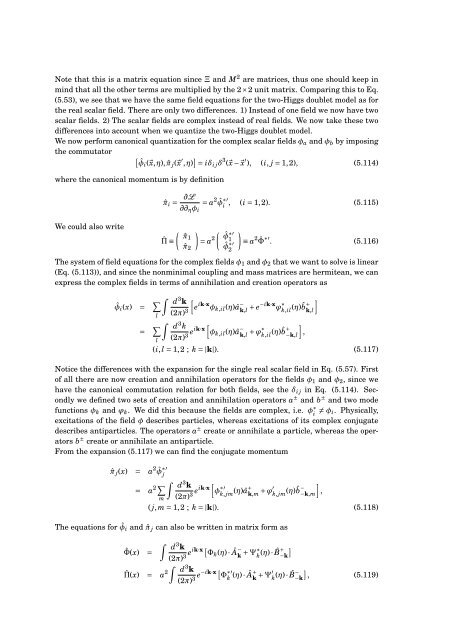Master's Thesis in Theoretical Physics - Universiteit Utrecht
Master's Thesis in Theoretical Physics - Universiteit Utrecht
Master's Thesis in Theoretical Physics - Universiteit Utrecht
Create successful ePaper yourself
Turn your PDF publications into a flip-book with our unique Google optimized e-Paper software.
Note that this is a matrix equation s<strong>in</strong>ce Ξ and M 2 are matrices, thus one should keep <strong>in</strong>m<strong>in</strong>d that all the other terms are multiplied by the 2×2 unit matrix. Compar<strong>in</strong>g this to Eq.(5.53), we see that we have the same field equations for the two-Higgs doublet model as forthe real scalar field. There are only two differences. 1) Instead of one field we now have twoscalar fields. 2) The scalar fields are complex <strong>in</strong>stead of real fields. We now take these twodifferences <strong>in</strong>to account when we quantize the two-Higgs doublet model.We now perform canonical quantization for the complex scalar fields φ a and φ b by impos<strong>in</strong>gthe commutator[ˆφi (⃗x,η), ˆπ j (⃗x ′ ,η) ] = iδ i j δ 3 (⃗x −⃗x ′ ), (i, j = 1,2), (5.114)where the canonical momentum is by def<strong>in</strong>itionWe could also writeˆπ i =∂L = a 2∂∂ η φ ˆφ∗′ i, (i = 1,2). (5.115)i( ) (ˆπ1ˆΠ ˆφ∗′≡ˆπ = a 2 12ˆφ ∗′2)≡ a 2 ˆΦ ∗′ . (5.116)The system of field equations for the complex fields φ 1 and φ 2 that we want to solve is l<strong>in</strong>ear(Eq. (5.113)), and s<strong>in</strong>ce the nonm<strong>in</strong>imal coupl<strong>in</strong>g and mass matrices are hermitean, we canexpress the complex fields <strong>in</strong> terms of annihilation and creation operators asˆφ i (x) = ∑ ∫ d 3 k[l (2π) 3 e ik·x φ k,il (η)â − k,l + e−ik·x ϕ ∗ k,il (η) ˆb]+k,l= ∑ ∫ d 3 k[ eik·xl (2π) 3 φ k,il (η)â − k,l + ϕ∗ k,il (η) ˆb]+−k,l,(i, l = 1,2 ; k = |k|). (5.117)Notice the differences with the expansion for the s<strong>in</strong>gle real scalar field <strong>in</strong> Eq. (5.57). Firstof all there are now creation and annihilation operators for the fields φ 1 and φ 2 , s<strong>in</strong>ce wehave the canonical commutation relation for both fields, see the δ i j <strong>in</strong> Eq. (5.114). Secondlywe def<strong>in</strong>ed two sets of creation and annihilation operators a ± and b ± and two modefunctions φ k and ϕ k . We did this because the fields are complex, i.e. φ ∗ i ≠ φ i. Physically,excitations of the field φ describes particles, whereas excitations of its complex conjugatedescribes antiparticles. The operators a ± create or annihilate a particle, whereas the operatorsb ± create or annihilate an antiparticle.From the expansion (5.117) we can f<strong>in</strong>d the conjugate momentumˆπ j (x) = a 2 ˆφ∗′ j= a 2 ∑ ∫ d 3 k[ eik·xm (2π) 3 φ ∗′k, jm (η)â+ k,m + ϕ′ k, jm (η) ˆb]−−k,m,( j, m = 1,2 ; k = |k|). (5.118)The equations for ˆφi and ˆπ j can also be written <strong>in</strong> matrix form asˆΦ(x) =∫d 3 k(2π) 3 eik·x [ Φ k (η) · Â− k + Ψ∗ k (η) · ˆB + −kˆΠ(x) = a 2 ∫ d 3 k(2π) 3 e−ik·x [ Φ ∗′k (η) · Â+ k + Ψ′ k (η) · ˆB − −k], (5.119)]
















